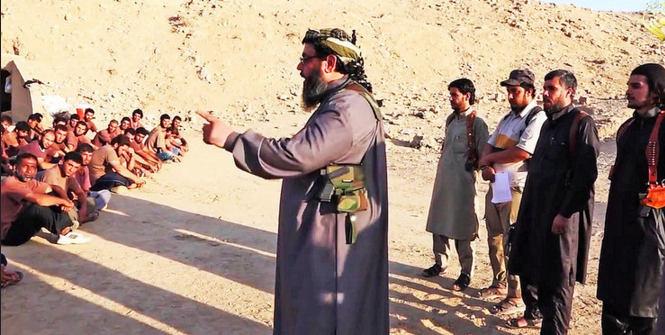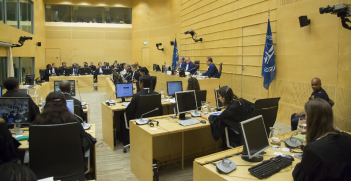Islamic State's Information Operations Strategy

The war against Islamic State (IS) is one of the most pressing security issues facing the world today, and combating IS’s information operations (IO) – i.e. its multidimensional communications strategy – has been identified as a crucial component of this campaign.
Horrific IS videos, typically released by one of its central media units (for example, al Hayat), have dominated media reporting since the beheading of James Foley in August 2014. From this perspective, and it is one which has significantly shaped public strategic-policy discourse, it would seem that IS’s IO campaign is dominated by its central media units, whose communiqués act as instruments of proselytisation and terror.
While this is true to a degree, as is the case with so much about IS, the reality is more complex. First, IS’s central media units produce only a small portion of IS’s total IO output, of which violence is far from a universal theme. A more nuanced perspective of IS communications will be essential if its influence on both local and transnational audiences is to be thwarted.
IS’s media architecture
West Point Military Academy’s The Group That Calls Itself a State contains a comprehensive analysis of IS’s media organisation, and the picture that emerges is one of an insurgency that prioritises IO as a central pillar of its campaign:
The media proficiency of the IS exists because of an extensive media infrastructure that allows it to produce high-quality, timely products in different languages to different audiences that fit the narrative that the group wishes to convey. In addition to the production side, the IS is also capable of pushing this narrative out along a number of mediums, to include the internet, broadcast airways, and traditional publications.
There are three levels to IS’s media architecture: central media units, provincial information offices and its broader membership/supporter base. IS’s central al Hayat, al-Furqan, al-Itisam and Ajnad media centres tend to produce IO that are disseminated online and designed for transnational audiences. Messages from its central media units focus predominantly on major announcements from IS’s central command, raising the profile of key events and issues or, in the case of Ajnad, producing audio nasheeds (“hymns”) and sura recitations. Targeting predominantly regional and local audiences, IS’s wilayatinformation offices produce communiqués that focus on more localised issues and events, using mainly local platforms such as billboards, radio, posters and public events to disseminate its messages.
In addition to these “official” streams of IS messaging, IS’s members and supporters play a crucial role in disseminating IS’s official communiqués (exponentially increasing the reach of its IO) and producing and disseminating “unofficial” IO messaging (exponentially increasing the volume of IS’s IO output). J. M. Berger and Jonathon Morgan’s The ISIS Twitter Census reveals how IS supporters from around the world have used thousands of Twitter accounts, attracting large “follower” numbers, and high-volume messaging and activity in an effort to dominate the social media forum. The efficacy of IS’s IO, or what Milton describes as its “media proficiency”, is undoubtedly enabled by IS’s tri-tiered media architecture. This naturally raises the question: what is the purpose of IS messaging?
Shaping perceptions, polarising support
Whether produced by one of its central media units or a wilayat-based “information office”, IS messaging seeks, first and foremost, to shape the perceptions of its audiences – both friends and foes – and polarise their support. IS communiqués are designed to influence how its audiences understand and evaluate the conflict as a clash of competing politico-military apparatuses (systems of control) and agendas (systems of meaning).
Like almost any modern insurgency, IS recognises that, in attempting to implement its own competitive system of control, it must be seen to be filling not only a politico-military void – and the pragmatic needs of stability, security and livelihood that entails – but also a vacuum of values and meaning, which is addressed by influencing the populations’ perceptions in such a way as to stir them towards its vision. In the twenty-first century, this requires a multidimensional communications strategy targeting “glocal” audiences.
Two sets of factors play a central role in IS messaging. The first is pragmatic factors – of which stability, security and livelihoods are central – which IS appeals to by promoting the efficacy of its politico-military campaign and synchronising the link between its narrative and action. Conversely, IS draws on these same factors to denigrate the politico-military efforts of its opponents (i.e. their inability to provide stability, security and livelihoods) while constantly looking to rupture the link between its enemies’ narrative and action. Ultimately, IS’s appeals to pragmatic factors seek to leverage a “logic of consequence” decision-making (i.e. rational choices based on cost – benefit analysis of alternatives).
Secondly, perceptual factors – characterised by the interplay of in-group identity, out-group identity, crisis and solution constructs – are used by IS in messages to leverage identity-choice rationale, or what March and Heath (1994, 57–102) describe as “logic of appropriateness” decision-making (i.e. choices made in accordance with one’s identity). The interplay of dichotomous identities, crisis and solution constructs is a common communication strategy used by radical groups, such as the Pakistani Taliban, and charismatic leaders, such as Osama Bin Laden and Anwar al-Awlaki. IS’s narratives portray IS as the champion of Sunni Muslims (in-group identity), its enemies as evil Others (Shias, Christians, non-conformist Sunnis) who are responsible for Sunni perceptions of crisis, and IS as the only source of solutions.
The result is a competitive system of meaning that acts as a framework through which IS’s audiences perceive and evaluate the conflict and its actors, generate meaning and legitimise actions.
IS communiqués rarely appeal to pragmatic or perceptual factors in isolation. Rather, these appeals are woven together into narratives that are reinforced by emotive imagery and powerful symbolism. This approach imbues IS messaging with a greater potential to resonate with the broadest spectrum of potential supporters. For example, pragmatic factors are likely to be more pertinent for local populations—a sentiment that was expressed to the author in a series of interviews in December 2014, January 2015 and March 2015 with former residents of IS- and rebel-controlled areas in Syria and Iraq.
In contrast, perceptual factors are likely to have greater resonance with transnational audiences. Furthermore, simultaneous appeals to pragmatic and perceptual factors create mutually reinforcing narrative cycles, whereby the veracity of IS’s system of meaning is evidenced in the efficacy of its politico-military apparatus (and vice versa). This may go some way to understanding how IS messaging seems to rapidly radicalise its supporters because, in weaving together appeals to pragmatic and perceptual factors, IS communiqués are designed to align rational- and identity-choice decision-making in its audiences. The more rational-choice decisions are processed from the perspective of IS’s system of meaning, the greater the potential for its messages to resonate, influence and act as a driver of mobilisation.
Dr Haroro J. Ingram is a Research Fellow at the Coral Bell School of Asia Pacific Affairs at the Australian National University. This article is an edited extract from ‘The Strategic Logic of Islamic State Information Operations’ published in full in the Australian Journal of International Affairs Volume 69, Issue 6, 2015.




